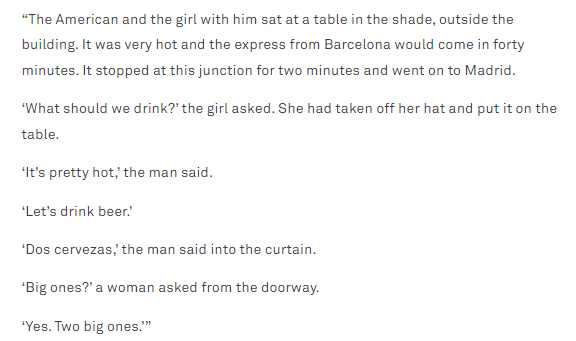What Does Writing Point of View Mean and How Does It Work?

Every written work expresses a point of view. A point of view can be found in a novel, an academic research paper, a journal, and this blog post. The standpoint from which a story is told in writing is known as the point of view. Where is the narrator? It is a straightforward point of view.
What does point of view mean?
The writer uses point of view to determine who is telling the narrative to whom. Establishing a distinct point of view is critical since it affects how your reader perceives characters, events, and other crucial elements. The first-person, second-person, and third-person are the three different types of points of view.
First-person point of view
The reader is given access to the story through one person in first-person point of view. It’s like reading the diary of the main character. In first-person writing, you’ll see pronouns like I, me/my, we, us, or ours. It restricts how much a reader can learn about other characters, but it is most accurate to how real people behave.
There are two approaches to first-person writing:
First-person main character: The narrator is the story’s main character. For instance, Scout is the main character, and the narrator in To Kill a Mockingbird, written in the first-person.
First-person peripheral: The narrator describes the protagonist’s story while standing nearby. The Great Gatsby by F. Scott Fitzgerald is a well-known illustration. Nick, a friend and neighbour of Gatsby, serves as the narrator of the story rather than Gatsby himself.
Why use first-person in writing?
Identification: Because the reader is learning details right along with the narrator, they have a stronger connection to them. Writing in the first-person gives the impression that “we’re in this together.”
Viewpoint: It’s a good idea to state whose opinion it is if your essay relies significantly on opinions. It could be the author’s viewpoint or the viewpoint of a fictional character. Using the pronoun, I guarantee that the opinion won’t be taken as reality in any case.
Intrigue: Creating mystery surrounding other characters can be made easier by the writer by taking advantage of a character’s knowledge limitations. For instance, The Great Gatsby’s narrator’s detachment from the subject makes Gatsby seem mysterious.
Second-person point of view
The pronoun you is used when speaking in the second-person. From this point of view, the reader is introduced as the protagonist or main character. In a longer creative writing piece, it is hard to maintain a point of view. If you’re a writer, do you want your audience to be involved and engrossed, engaged, and fascinated? Second-person has its place and time in nonfiction, advertising, immersive stories, and this blog post. In this article, we’ll discuss some second-person point-of-view examples in novels. Just be aware that it’s the most difficult and infrequently used point of view in literature.
Why use second-person in writing?
Uniqueness: The second-person point of view is uncommon in creative writing. Write in the second-person for a creative challenge or to give your reader a unique experience.
Space for reflection: When you use the pronoun ‘you’ in writing, you speak directly to the reader. It is a practical strategy for creating room for their introspection.
Third-person point of view
From third-person perspective, the narrator has complete knowledge. From third-person point of view, you’ll encounter the pronouns he/his, she/her, they/them/their, and it/its. The maximum flexibility and complexity can be achieved from this point of view.
Writing in the third-person can be done in one of three ways:
Third-person omniscient: The narrator discusses everyone and everything without restraint. The narrator has unlimited access to all points in time, location, and characters.
Third-person limited omniscient (also called third-person close): Although the author writes in the third-person, only one main character’s ideas and emotions are included. A good example of third-person limited omniscient literature is the Harry Potter series. Although the reader can access scenes from several eras and locations, they are always in Harry’s thoughts.
Third-person objective: The narrator is a detached observer who doesn’t get inside the characters’ thoughts. It is written as if it were a fly on the wall. Third-person objective writing was a speciality of Ernest Hemingway’s. The most well-known example of this uncommon genre of fiction is the short story “Hills like White Elephants” by Ernest Hemingway.
Why use the third-person in writing?
Complexity: Third-person writing offers countless options. Because the writer is not constrained by the thoughts, observations, or actions of a single character, they are free to create worlds, plots, and characters that are more intricate.
Authoritative narrator: Being biased is inherent in human nature, so deleting the speaker’s subjectivity can lead to authoritativeness in writing.
Steps to develop a point of view in writing
If you’ve always written in first-person central in your journal, it’s unlikely that you’ve ever stopped considering whether you should do the same for this entry. Your decision is automatic. The viewpoint that comes to you most naturally is usually the accurate one. Here are some things to think about if you want to be more intentional about your point of view or try a novel approach:
- Consider the genre: Is there any well-known point of view for the kind of writing you’re producing? Viewing different examples can help you. For example, essays having a personal touch are generally written in first-person, books providing self-help have a second-person point of view, and journalism has a third-person point of view. Switch to writing you connect with or admire the most and determine the type of point of view used in it.
- Think about complexity: If you want to use the first-person, you need to have a sound understanding of the narrator, but if you want to use the third-person, you need to have knowledge of all characters.
- Immediately establish the point of view: The readers should understand the point of view immediately. Therefore, it is a good practice to fix the viewpoint for the reader within the first two paragraphs.
- Believe in your gut: If you have many things to write, pen them down. You can write something in both ways, that is first-person and third-person, if you are unsure which one is better to use. Think about the point of view which comes naturally and the one which sounds forceful. It is often found that the viewpoint which feels good to write is better to read.
Is there an option to switch points of view?
Since there is an unwritten agreement regarding the point of view between you and your reader, make an attempt to maintain consistency. An abrupt shift in opinions would be like calling your mother by her first name; it would be upsetting for everyone. You wouldn’t contact her office and request to talk with “mom,” though. Nevertheless, there are some uncommon but acceptable circumstances where it makes sense to switch points of view.
One situation is when you want the reader to pause and reflect. You might switch to a second-person point of view in this situation. For instance, if an allegory ends with a moral dilemma, the author may move to the second-person and inquire about what you, the reader, might do. It is one method in which you can employ the literary device of points of view to improve your work. Some writers, such as Italo Calvino and Haruki Murakami, purposely switch points of view throughout their works as a creative technique to improve the reader’s experience.
Examples of point of view
Every essay has a point of view, as we already stated and here are some examples of them:
First-person (peripheral)
The narrator in the above text uses ‘I’ for Nick. Gatsby is the book’s main character, but the reader learns the story from the viewpoint of a nearby narrator.
Second-person
Calvino was renowned for using creative writing methods. In this example, Calvino advises the reader on how to read his book from the first few words of his book, which is written in the second-person.
Third-person (objective)
The above excerpt is described from the viewpoint of a bystander. Since the narrator is not speaking for themselves (there is no “I”), the reader has equal access to all of the characters’ actions. All of it is observational.
Point of view FAQs
What does point of view in writing mean?
In writing, point of view refers to the narrator’s standpoint to talk. What matters is who is speaking to whom.
What is the process of point of view?
The author’s point of view is communicated using pronouns, identifying the narrator’s position. The narrator writes the entire piece in first-person and always refers to himself as I. The narrator addresses the audience as you in second-person. The third-person narrator used the pronouns she, he, they, and it.
Can you name the different kinds of points of view?
The first-person, second-person, and third-person are the three different types of points of view.
When should you write from a particular point of view?
Every written work expresses a point of view. Sometimes the genre in which we are writing determines the point of view for us. For instance, the third-person is necessary to be used in journalism writing.
Each point of view has distinct advantages and disadvantages; thus, it is up to the author to select the one that best supports their work.
Total Assignment Help
Incase, you are looking for an opportunity to work from home and earn big money. TotalAssignmenthelp Affiliate program is the best choice for you.
Do visit : https://www.totalassignmenthelp.com/affiliate-program for more details
Total Assignment help is an assignment help online service available in 9 countries. Our local operations span across Australia, US, UK, South east Asia and the Middle East. With extensive experience in academic writing, Total assignment help has a strong track record delivering quality writing at a nominal price that meet the unique needs of students in our local markets.
We have specialized network of highly trained writers, who can provide best possible assignment help solution for all your needs. Next time you are looking for assignment help, make sure to give us a try.
Looking for Assignment Help from Top Experts ?
Get the best Assignment Help from leading experts from the field of academics with assured onetime, 100% plagiarism free and top Quality delivery.






